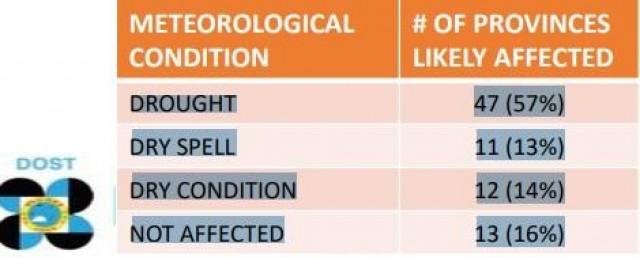Looming El Niño to affect 47 provinces in first quarter of 2019
The probable occurrence of El Niño may usher in hotter days on the first quarter of 2019 and may affect 47 provinces, PAGASA said Thursday in its Climate Outlook for the year.
According to its forecast, the first months of the year will likely be more sweltering compared to the same period in 2018 because of lessened rainfall and dry winds caused by the phenomenon.
The public should conserve water as early as now, the state weather bureau advised, noting that the dry spell has 70 to 80 percent chance of occurring.
A total 47 provinces are likely to be affected by drought; 11 provinces by dry spell; 12 provinces by dry condition; while 13 provinces will not experience the condition.

PAGASA described drought as three consecutive months of way below normal rainfall (60 percent reduction from average) or five consecutive months of below normal rainfall condition (21 percent to 60 percent reduction from average).
A “dry spell” is defined as three consecutive months of below normal rainfall (21 percent to 60 percent reduction from average) or two months of consecutive way below normal rainfall (more than 60 percent reduction from average).
Dry condition is defined as having two consecutive months of below normal rainfall (21-60 percent drop in average rainfall).
Most of the villages in the town of Mlang in North Cotabato province are already experiencing the mild effect of drought as severe temperature since mid-December dried up their irrigation canals.
On the other hand, the water level in a filtration plant in Zamboanga City has significantly dwindled and residents are experiencing difficulty in the water supply.

Experts said that the phenomenon may delay the rainy season and incur damage to agriculture, especially to water-intensive crops such as rice and corn.
The country experienced El Niño in 2015 and 2016.
One of its major repercussions were the P15.2 billion production loss in the agricultural sector after 1.48 tons of produce were ruined.
Around 400,000 farmers in 57 provinces and two cities were hardly-hit by the impact of the phenomenon, with Bukidnon, Nueva Ecija, Iloilo, North Cotabato, and Isabela bearing much of the agricultural damage.
More than a hundred local government units have also declared a state of calamity during that period. —LDF, GMA News




